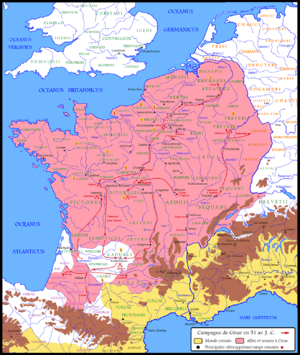Uxellodunum facts for kids
Uxellodunum was an ancient hill fort or oppidum from the Iron Age. It was built high above the Dordogne River in what is now France, near the village of Vayrac. This strong fort was in the land of the Cadurci tribe.
According to Aulus Hirtius, who added to Julius Caesar's Commentaries on the Gallic War, Uxellodunum was the site of the very last rebellion against Roman rule in Gaul. The Romans punished this rebellion very harshly.
Caesar's writings describe Uxellodunum as a naturally strong fort. A river flowed through the valley below, almost surrounding the steep, rocky mountain where the fort stood. The name "Uxellodunum" likely means "high fort." The word "dun" is an old Celtic word for a fort, found in many place names.
What Happened at Uxellodunum?
Most of what we know about the siege of Uxellodunum in 51 BC comes from Book 8 of Caesar's Commentaries on the Gallic War. The engineer Sextus Julius Frontinus also briefly mentions the siege in his book Stratagems.
The siege began when Lucterius, the leader of the Cadurci, and Drapes from the Senones tribe, prepared Uxellodunum to defend against a Roman attack. Gaius Caninius Rebilus, a Roman commander in the area, brought his two legions to the fort. When Caesar learned about the situation, he decided to take charge of the siege himself.
How Did the Romans Win the Siege?
When Caesar arrived at Uxellodunum, he saw that the Romans had already surrounded the town. He also learned that the people inside had plenty of food. However, he noticed they might have trouble getting water. A river flowed in the valley below, almost wrapping around the steep mountain where Uxellodunum was built.
It was hard for the Romans to block the river directly because it flowed so low. But the path down to the river was very difficult. If the Romans guarded it, the people inside the fort would risk their lives trying to get water. Caesar placed archers, slingers, and war machines at the easiest paths down. This made it very hard for the defenders to get water, forcing them to use only one dangerous spot.
Caesar believed that if he allowed more revolts, his work in Gaul would never be finished. He also thought that people knew he was usually fair. So, he decided to make an example of the defenders of Uxellodunum to stop future rebellions. He ordered that all who had fought against Rome have their hands cut off. Then, he let them go so that everyone would see the punishment for fighting Rome.
Where is Uxellodunum Today?
For a long time, people debated exactly where Uxellodunum was located. In the 19th century, some thought it was at Capdenac-le-Haut, while others suggested Cantayrac.
Napoleon III, a French emperor, studied Julius Caesar's history. He noticed features at a place called Puy d'Issolud that seemed to match the water systems used during the siege. Later, archaeological digs confirmed that the ancient fort was indeed at Puy d'Issolud. Weapons and other items from that time have been found there. The site (44°57′N 1°41′E / 44.95°N 1.68°E) was officially recognized by the French Ministry of Culture in 2001.
You can see many items found at Puy d'Issolud in the Musée d'Uxellodunum in the town of Martel. There is also another Musée Uxellodunum in Vayrac. People have suggested making the site itself more visitor-friendly, with signs and information for those who want to explore this important historical place.


